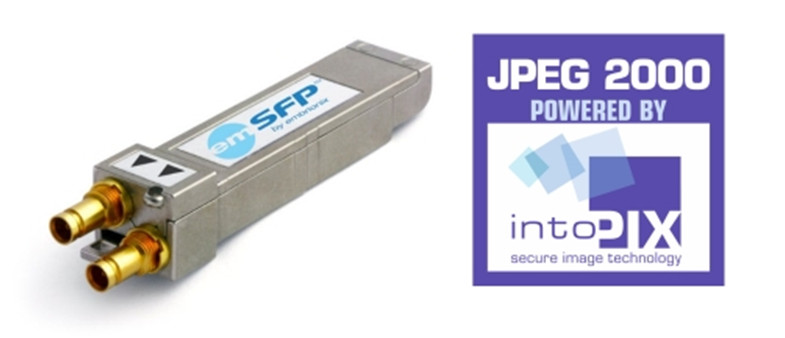JPEG 2000 compression is used in the Digital Cinema world to encode movies for distribution to the theater. It is also used in broadcast for contribution signals. It is an image based compression scheme that offers relatively low levels of compression with a visually lossless result. At NAB 2015, we learned of two new implementations that will use the compression scheme to deliver video over an Ethernet network.
The first is a product from Embrionix that offers JPEG 2000 compression in a SFP format. I did not know what SPF meant, so I looked it up. It stands for Small Form-factor Pluggable (SPF) and is essentially a small transceiver that plugs into the SFP port of a network switch and connects to Fibre Channel and Gigabit Ethernet (GbE) optical fiber cables at the other end. By choosing the appropriate SFP module, the same electrical port on the switch can connect to fibers of different types (multimode or singlemode) and different wavelengths. If the fiber is upgraded, the SFP module is replaced.
This innovative SFP module follows the Video Services Forum (VSF) recommendation TR01 for Transporting JPEG 2000 Broadcast Profile video in MPEG-2 TS over IP. While this recommendation is dated April 2013, this may be one of the first implementations of the recommendation in an SPF device. When we asked SMPTE if there was an equivalent standard in that organization, the answer was no – it has not been passed to their group for consideration yet.
Inside the emSFP device is an FPGA module that contains the JPEG 2000 IP core from IntoPIX. “Embrionix successfully ported our JPEG 2000 FPGA IP-core into a SFP module, previously perceived as an impossible challenge.” said Gael Rouvroy, intoPIX CTO and founder.
The new product is intended for live production workflows enabling HD video to be visually lossless compressed with the lowest latency. A 1080p/60 video stream will typically compress down to a range of 150-400 Mbps.
The SFP product configuration is potentially disruptive as it allows existing switches that have SPF ports to be upgraded to support JPEG 2000 deployment in broadcast infrastructures for video over IP.
 Embrionix SFP powered by intoPIX JPEG2000 technology
Embrionix SFP powered by intoPIX JPEG2000 technology
Also at NAB, Barco Silex is releasing a new video-over-IP reference design based upon their JPEG 2000 IP core. This core is implemented in an FPGA from Xilinx and likewise conforms to the VSF TR-01 recommendation for implementation.
As a reference design, it is targeted at broadcast equipment OEMs who want to use the design in equipment they will offer to the industry.
The reference design is a four-channel transmitter-and-receiver platform. The transmitter is able to take up to four SDI high-definition (HD) streams (1080p30), optionally compress them with JPEG 2000 and send them over 1-Gbps (with compression) or 10-Gbps (uncompressed) Ethernet according to the VSF TR-01 standard. The receiver platform, conversely, can receive the IP stream, de-encapsulate and decompress it, and put it on up to four SDI HD links. Using the four input channels of the reference design in quad-SDI mode (4K carried over four SDI cables), the design is ready to send 4K signals over the network.
The design has been implemented on two platforms, one using Xilinx’ Zynq-7000 All Programmable SoC and the other using the Kintex-7 FPGA allowing integrated solutions that address the complete range of OEM system requirements, from low-cost, high-volume applications to the most demanding high-performance applications.
The design includes the Barco Silex JPEG 2000 encoder and decoder IP cores. These are silicon-proven, widely adopted single-FPGA solutions for high-performance, simultaneous multichannel 720p30/60, 1080i, 1080p30/60 and 2K/4K/8K JPEG 2000 encoding and decoding.

